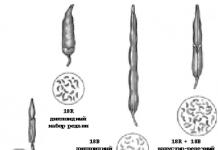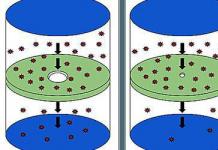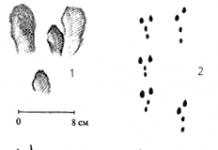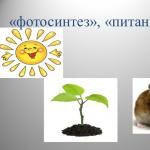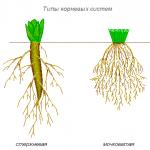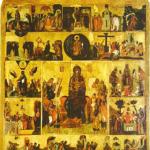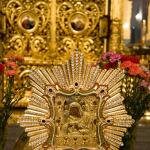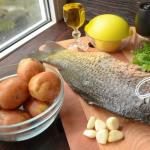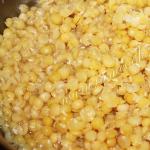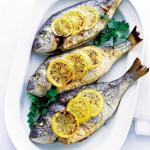Indicators |
Natural selection |
Artificial selection |
Source material for selection |
Individual characteristics of the body |
|
Selective factor |
Environmental conditions |
|
The path of favorable changes |
Selected, become productive |
Remains, accumulates, is inherited |
The Path of Unfavorable Change |
Selected, rejected, destroyed |
Destroyed in the struggle for existence |
Nature of action |
Creative – directed accumulation of characteristics for the benefit of a person |
Creative - selection of adaptive traits for the benefit of an individual, population, species, leading to the emergence of new forms |
Selection result |
New plant varieties, animal breeds, microorganism strains |
New species |
Selection forms |
Mass, individual, unconscious, methodical |
Driving, stabilizing, destabilizing, disruptive, sexual |
Lesson 5–6. Plant breeding
Equipment: tables on general biology illustrating the diversity of breeds and varieties, basic methods and achievements of plant breeding.
DURING THE CLASSES
I. Test of knowledge
A. Oral knowledge test
1. Ch. Darwin on the reasons for the diversity of breeds and varieties.
2. Forms of artificial selection and their characteristics.
3. The creative role of artificial selection.
B. Working with cards
№1. Why can a breed or variety be considered a man-made population, i.e. a population created by the will and efforts of people?
№2. Show with examples the influence of selection on the directions of breed and variety formation.
№3. Why is mass selection used for cross-pollinated plants? Does mass selection produce genetically homogeneous material? Why is repeated selection necessary during mass selection?
II. Learning new material
1. Features of plant biology taken into account in breeding
In breeding, it is necessary to take into account the following features of plant biology:
– high fertility and large number of offspring;
– presence of self-pollinating species;
– the ability to reproduce by vegetative organs;
– the possibility of artificially obtaining mutant forms.
These plant characteristics determine the choice of breeding methods.
2. Crossbreeding as a method of increasing the diversity of material for artificial selection
The main methods of plant breeding are hybridization and selection. Usually these methods are used together. Hybridization increases the diversity of the material with which the breeder works. But in itself, most often, it cannot lead to a targeted change in characteristics in organisms, i.e. Crosses without artificial selection are ineffective. Crossing is preceded by careful selection of parental pairs. For the successful search, selection and use of source material, the teachings of N.I. are of great importance. Vavilov on the centers of origin of cultivated plants, his law of homological series in hereditary variability, ecological and geographical principles of plant taxonomy, as well as created by N.I. Vavilov, his followers and students, a collection of agricultural plants.
Hybridization can be carried out according to different schemes. There are simple (paired) and complex (step, return, or backcross) crosses.
Simple
, or doubles
, is called a cross between two parent forms, performed once. A variety of them are the so-called mutual(reciprocal) crossing. Let us recall that their essence is that two crossings are carried out, and the paternal form of the first crossing is used in the second crossing as the maternal one, and the maternal form is used, respectively, as the paternal one. Such crosses are used in two cases: when the development of the most valuable trait is determined by cytoplasmic heredity (for example, frost resistance in some varieties of winter wheat) or when seed set in hybrids depends on whether one or another variety is taken as the maternal or paternal form. Reciprocal crosses show that sometimes the influence of the cytoplasm of the maternal variety is very significant.
Thus, at the Research Institute of Oilseeds named after. V.S. Pustovoit (Krasnodar), as a result of reciprocal crossings of sunflower varieties 3519 and 6540, intervarietal hybrids were obtained, which differed significantly (2.5 times) in the degree of infection by broomrape, depending on which variety was taken as the mother and which - as a paternal form. Naturally, hybrids with greater resistance to broomrape were included in the breeding process.
Complex
are called crosses in which more than two parental forms are used or repeated crossing of hybrid offspring with one of the parents is used. There are stepwise and recurrent complex crosses.
Complex stepwise hybridization is a system of successive crossings of the resulting hybrids with new forms, as well as hybrids with each other. In this way, the best qualities of many original forms can be collected in one variety. This method was first developed and successfully applied by the famous Soviet breeder A.P. Shekhurdin in the creation of soft spring wheat varieties Lutescens 53/12, Albidum 43, Albidum 24, Steklovidnaya, Saratovskaya 210, Saratovskaya 29, etc., as well as a number of varieties of durum spring wheat.
At backcrossings the resulting hybrids are crossed with the parental form whose trait they want to enhance. If such crosses are repeated many times, they are called saturating, or absorbent(backcrosses). In this case, the hybrid is saturated with the genetic material of one of the parents, and the genetic material of the other parent is displaced (absorbed), and in the genome of the hybrid one or more genes remain that are responsible for some valuable trait, for example, drought resistance or resistance to one of the diseases. As a rule, local wild-growing forms are used as donors of such traits, which are most often low-productive, which is why breeders have to resort to backcrosses.
The following types of crosses are used in plant breeding.
Inbreeding, or inbreeding, are used as one of the stages of increasing productivity. To do this, self-pollination of cross-pollinated plants is carried out, which leads to increased homozygosity. After 3-4 generations, so-called pure lines arise - genetically homogeneous offspring obtained by individual selection from one individual or a pair of individuals in a series of generations. Many abnormal traits are recessive. In pure lines they manifest themselves phenotypically. This leads to an adverse effect, a decrease in the viability of organisms, called inbred depression. But, despite the unfavorable effect of self-pollination in cross-pollinated plants, it is often and successfully used in breeding to obtain pure lines. They are necessary for the hereditary consolidation of desirable, valuable traits, as well as for interline crossing. In self-pollinating plants, there is no accumulation of unfavorable recessive mutations, because they quickly become homozygous and are eliminated by natural selection.
Interline crossing– cross-pollination between different self-pollinating lines, as a result of which in some cases high-yielding interline hybrids appear. For example, to obtain interline hybrids of corn, panicles are picked from selected plants and, when the stigmas of the pistils appear, they are pollinated with pollen from the same plant. To prevent pollination from pollen from other plants, the inflorescences are covered with paper insulators. In this way, several pure lines are obtained over a number of years, and then the pure lines are crossed with each other and those whose offspring give the maximum increase in yield are selected.
Intervarietal crossing– crossing plants of different varieties with each other in order to demonstrate combinative variability in hybrids. This type of crossing is the most common in breeding and underlies the production of many high-yielding varieties. It is also used for self-pollinating species, such as wheat. The anthers of the flowers of a plant of one wheat variety are removed, a plant of another variety is placed next to it in a jar of water, and both plants are covered with a common insulator. As a result, hybrid seeds are obtained that combine the characteristics of different varieties desired by the breeder.
Distant hybridization- crossing of plants of different species, and sometimes genera, contributing to the production of new forms. Usually crossing occurs within a species. But sometimes it is possible to obtain hybrids from crossing plants of different species of the same genus or even different genera. Thus, there are hybrids of rye and wheat, wheat and the wild grass Aegilops. However, distant hybrids are usually sterile. Main causes of infertility:
– in distant hybrids the normal course of maturation of germ cells is usually impossible;
– the chromosomes of both parental plant species are so dissimilar to each other that they are unable to conjugate, as a result of which a normal reduction in their number does not occur, and the process of meiosis is disrupted.
These disturbances turn out to be even more significant when the crossing species differ in the number of chromosomes (for example, the diploid number of chromosomes in rye is 14, in bread wheat - 42). There are many cultivated plants created as a result of distant hybridization. For example, as a result of many years of work by Academician N.V. Tsitsin and his colleagues obtained valuable varieties of cereals based on the hybridization of wheat with the perennial weed wheatgrass. As a result of the hybridization of wheat with rye (these hybrids are usually sterile), a new cultivated plant was obtained, called triticale (lat. triticum– wheat, secal– rye). This plant is very promising as a fodder and grain crop, producing high yields and resistant to adverse environmental influences.
3. The phenomenon of hybrid vigor and its genetic basis
Back in the middle of the 18th century. Russian academician I. Kelreuter drew attention to the fact that in some cases, when crossing plants, first-generation hybrids are much more powerful than the parent forms. Then Charles Darwin concluded that hybridization in many cases is accompanied by more powerful development of hybrid organisms. The higher viability and productivity of first-generation hybrids compared to crossed parental forms is called heterosis. Heterosis can occur when crossing breeds in animals, varieties and pure lines in plants. Thus, an intervarietal hybrid of Grushevskaya and Dnepropetrovskaya corn gives an 8–9% increase in yield, and an interline hybrid of two self-pollinating lines of the same varieties gives a 25–30% increase in yield. Cases of heterosis are also known in distant crossings of species and genera of plants and animals.
Thus, the phenomenon of heterosis as a hereditary expression of the effects of hybridization has been known for a long time. However, its use in the breeding process began relatively recently, in the 1930s. The discovery and understanding of the phenomenon of heterosis made it possible to determine a new direction in the selection process - the creation of highly productive hybrids of plants and animals.
A new period in the study of the phenomenon of heterosis begins in the 20s. XX century from the works of American geneticists J. Schell, E. East, R. Hell, D. Jones. As a result of their work in corn, through self-pollination, inbred lines were obtained that differed from the original plants in reduced productivity and viability, i.e. severe inbreeding depression. But when Schell crossed pure lines with each other, he unexpectedly received very powerful hybrids of the first generation, significantly superior in all productivity parameters to both the original lines and the varieties from which these lines were obtained by self-pollination. With these works, the widespread use of heterosis in the breeding process began.
What explains the phenomenon of heterosis, i.e. power of hybrids, from a genetic point of view? Geneticists have proposed several hypotheses to explain it. The most common are the following two.
Dominance hypothesis developed by American geneticist D. Jones. It is based on the idea of favorably acting dominant genes in a homozygous or heterozygous state. If the crossed forms have only two dominant beneficially acting genes ( AAbbCCdd x aaBBccDD), then the hybrid has four ( AaBbCcDd), regardless of whether they are in a homozygous or heterozygous state. This, according to the supporters of this hypothesis, determines the heterosis of the hybrid, i.e. its advantages over the original forms.
Overdominance hypothesis proposed by American geneticists J. Shell and E. East. It is based on the recognition that heterozygous states for one or more genes provide an advantage over homozygous states for one or many genes. The diagram illustrating the hypothesis of overdominance in one gene is quite simple. It indicates that the heterozygous state for the gene Ahh has advantages in the synthesis of a gene-controlled product over homozygotes for alleles of this gene. Starting from the second generation of hybrids, the effect of heterosis fades, because some genes become homozygous:
P – Ahh X Ahh;
F2 – AA; 2Ahh; ahh.
There are a number of other hypotheses of heterosis. The most interesting of them, compensation gene complex hypothesis, suggested domestic geneticist V.A. Strunnikov. Its essence boils down to the following. Let mutations arise that greatly reduce viability and productivity. As a result of selection, a compensatory complex of genes is formed in homozygotes, which largely neutralizes the harmful effects of mutations. If you then cross such a mutant form with a normal one (without mutations) and thereby transfer the mutations to a heterozygous state, i.e. neutralize their effect with a normal allele, then the compensation complex that has developed in relation to mutations will provide heterosis.
Thus, despite the fact that the genetic basis of heterosis has not yet been fully elucidated, one thing is certain: high heterozygosity plays a positive role in hybrids, leading to the manifestation of increased physiological activity.
4. Overcoming the infertility of interspecific plant hybrids
Distant hybridization is not widely used in breeding due to the sterility of the resulting hybrids. One of the outstanding achievements of modern genetics and selection has been the development of a method for overcoming the infertility of interspecific hybrids, leading in some cases to the production of normally reproducing hybrids. This was first accomplished in 1922–1924. Russian geneticist, student of N.I. Vavilov, Georgy Dmitrievich Karpechenko (1899–1942) when crossing radish and cabbage. Both of these species have (in the diploid set) 18 chromosomes. Accordingly, their gametes carry 9 chromosomes (haploid set). The hybrid has 18 chromosomes, but it is completely sterile, because... “rare” and “cabbage” chromosomes do not conjugate with each other in meiosis.

Cabbage-raspberry hybrid (raphanobrassica)
G.D. Karpechenko doubled the number of chromosomes of the hybrid using colchicine. As a result, the hybrid organism had 36 chromosomes, consisting of two complete diploid sets of radish and cabbage. This created normal opportunities for meiosis, because Each chromosome had a pair. The “cabbage” chromosomes were conjugated with the “cabbage” chromosomes, and the “rare” chromosomes with the “rare” chromosomes. Each gamete carried one haploid set of radish and cabbage (9 + 9 = 18). Species in which there was a combination of different genomes in one organism, and then their multiple increase, are called allopolyploids. The zygote again had 36 chromosomes.
Thus, the resulting cabbage-radish hybrid, called Raphanobrassica, became fertile. The hybrid did not split into parental forms, because The chromosomes of radish and cabbage always ended up together. This man-made plant was neither radish nor cabbage. The pods consisted of two halves, one of which resembled a cabbage pod, the other - a radish. Distant hybridization combined with doubling the number of chromosomes (polyploidy) led to the restoration of fertility.
G.D. Karpechenko was the first to clearly demonstrate the relationship between distant hybridization and polyploidy in obtaining fertile forms. This has enormous implications for both evolution and selection.
5. Use of somatic mutations in plant breeding
The use of somatic mutations is applicable for the selection of vegetatively propagated plants. With the help of vegetative propagation, it is possible to preserve a useful somatic mutation or preserve and propagate any heterozygous form that has economically useful traits. For example, only through vegetative propagation are the properties of many varieties of fruit and berry crops preserved. During sexual reproduction, the properties of varieties consisting of heterozygous individuals are not preserved, and they split.
6. Artificial selection in plant breeding
As we have already said, hybridization is effective in selection only in combination with selection. In plant breeding, both mass and individual selection are used.
When carrying out mass selection, a group of plants with the best phenotypes is selected from a large number of individuals, the genotypes of which are unknown. Mass selection is carried out among cross-pollinated plants. The joint cultivation of selected plants promotes their free crossing, which leads to heterozygosity of individuals. Mass selection is carried out repeatedly in a series of subsequent generations. It is used when it is necessary to improve a particular variety relatively quickly. But the presence of modification variability reduces the value of varieties bred by mass selection.
Individual selection in plant breeding is used as a way to preserve the best plants for propagation. They are grown in isolation from each other in order to identify valuable traits in the offspring through comparison with the original forms and with each other. As we already know, most often the object of individual selection is self-pollinating plants, and its result is pure lines.
7. The role of natural selection in plant breeding
Natural selection plays a decisive role in selection. Any plant is affected by a whole range of environmental factors throughout its life, and it must be resistant to pests and diseases and adapted to a certain temperature and water regime. Therefore, thanks to natural selection, individuals develop adaptations to their environment. There cannot be cultivated plants that are equally productive in any area. Under the influence of natural selection, the zoning of varieties occurs.
8. Induced mutagenesis, polyploidy and their use in plant breeding
Induced mutagenesis is based on the exposure of the body to various radiations and chemical mutagens to produce mutations. Mutagens make it possible to obtain a wide range of different mutations. Out of 1 thousand artificially obtained mutations, 1–2 thousand turn out to be useful. But in this case, strict individual selection of mutant forms and further work with them are necessary.
Mutagenesis methods are successfully used in plant breeding. Nowadays, more than 1 thousand varieties have been created in the world, descending from individual mutant plants obtained as a result of artificial mutagenesis. The well-known spring wheat variety Novosibirskaya 67 was obtained at the Institute of Cytology and Genetics SB RAS after treating the seeds of the source material of the Novosibirskaya 7 variety with X-rays. This variety has a short and strong straw, which protects the plants from lodging during the harvest period.
The method of obtaining polyploid forms is also widely used in plant breeding. Polyploidy is a type of genomic mutation and consists of a multiple increase in the number of chromosomes compared to haploid. Polyploid forms can be obtained by treating seeds with colchicine during their germination.
A multiple increase in the number of chromosomes is accompanied by an increase in the weight of seeds and fruits, which leads to an increase in the yield of agricultural plants. Academician P.M. eloquently spoke about the role of the method of obtaining polyploids in plant breeding. Zhukovsky: “Humanity eats and dresses mainly with the products of polyploidy.” In Russia, experimentally obtained polyploid varieties of potatoes, wheat, sugar beets, buckwheat and other cultivated plants are widespread.
III. Consolidation of knowledge
Summarizing conversation while learning new material.
IV. Homework
Study the textbook paragraph (features of plant biology taken into account in breeding, basic methods of plant breeding and their characteristics).
To be continued
Artificial selection. To substantiate the historical principle of the development of living nature, Darwin deeply studied the centuries-old practice of agriculture and animal husbandry and came to the conclusion: the diversity of breeds of domestic animals and cultivated plant varieties is the result of variability, heredity and artificial selection.
Artificial selection is carried out by a person and can be twofold: conscious (methodical) - in accordance with the goal that the breeder sets for himself, and unconscious, when a person does not set a goal for breeding a breed or variety with predetermined properties, but simply eliminates less valuable ones individuals and leaves the best ones for the tribe. Unconscious selection has been carried out by humans for many millennia: even savages during famine left more useful animals for the tribe, and killed less valuable ones. In unfavorable periods, primitive man first of all consumed unripe fruits or smaller seeds, and in this case also made selection, but unconsciously. In all cases of such selection, the most productive forms of animals and more productive varieties of plants were preserved, although man here acted as a blind selection factor, like any other environmental factor. .1
Through centuries of artificial selection, many valuable forms have been developed. In particular, by the middle of the 19th century. More than 300 varieties of wheat were registered in agricultural practice, 38 varieties of date palm were cultivated in the deserts of North Africa, 24 forms of breadfruit and the same number of banana varieties were cultivated in Polynesia, and 63 varieties of bamboo were cultivated in China. There were about 1000 varieties of grapes, more than 300 gooseberries, about 400 breeds of cattle, 250 breeds of sheep, 350 breeds of dogs, 150 breeds of pigeons, many valuable breeds of rabbits, chickens, ducks, etc. Supporters of the constancy of species believed that each such variety or the breed originates from its direct ancestor. However, Darwin proved that the source of diversity in animal breeds and cultivated plant varieties is one or a small number of wild ancestors, whose descendants were transformed by man in different directions in accordance with his economic goals, tastes and interests. At the same time, the breeder used the hereditary variability inherent in the selected forms.
Darwin distinguished between definite (now called modification) and indefinite variability. With a certain, or group, variability, all or almost all the offspring of individuals exposed to the same conditions change in one direction; for example, when there is a lack of food, animals lose weight; in cold climates, mammals have thicker fur, etc. Uncertain, or individual, variability appears in the infinitely diverse, often barely noticeable, random, multidirectional deviations of individual individuals living together, within one species, one breed, one species. Currently, this form of variability is called genotypic. Variability is transmitted to offspring not only during sexual reproduction, but also during vegetative reproduction: often the plant grows shoots with new properties or develops buds, from which fruits with new qualities are formed (grapes, gooseberries) - the result of a mutation in the somatic cell of the bud.
In the phenomena of variability, Darwin discovered a number of important patterns, namely: when one organ or characteristic changes, others may change. For example, a crest develops at the site of attachment of the exercised muscle to the bone; in wading birds, the neck lengthens simultaneously with the lengthening of the limbs; the thickness of the hair in sheep changes accordingly with the increase in the thickness of the skin. Such variability is called correlative or correlative. Based on correlative variability, the breeder can predict certain deviations from the original form and carry out selection in the desired direction.
Natural selection Unlike artificial, it is carried out in nature itself and consists in the selection within the species of the most adapted individuals to the conditions of a particular environment. Darwin discovered a certain commonality in the mechanisms of artificial and natural selection: in the first form of selection, the conscious or unconscious will of man is embodied in the results, in the second, the laws of nature prevail. In both cases, new forms are created, but with artificial selection, despite the fact that variability affects all organs and properties of animals and plants, the resulting animal breeds and plant varieties retain characteristics that are useful for humans, but not for the organisms themselves. On the contrary, natural selection preserves individuals whose changes are useful for their own existence in given conditions.
In nature, definite and indefinite variability is constantly observed. Its intensity here is less pronounced than in domestic forms, since the change in the natural environment occurs unnoticeably and extremely slowly. The emerging qualitative heterogeneity of individuals within species, as it were, brings many “contenders” into the evolutionary arena, allowing natural selection to reject those less adapted to survival. The process of natural “culling,” according to Darwin, is carried out on the basis of variability, the struggle for existence and natural selection. The material for natural selection is supplied by the uncertain (genotypic) variability of organisms. It is for this reason that the offspring of any pair of wild (as well as domestic) organisms turns out to be heterogeneous. If the changes are beneficial, it increases the chances of survival and procreation. Any change harmful to the body will inevitably lead to its destruction or the inability to leave offspring. The survival or death of an individual is the final result of the “struggle for existence,” which Darwin understood not in a literal, but in a figurative sense. He distinguished three forms of struggle for existence:
A) intraspecific - the most fierce, since individuals of the same species need similar food sources, which are also limited, similar conditions for reproduction, identical shelters;
C) the struggle of living organisms with factors of inanimate nature - environmental conditions during drought, floods, early frosts, hail, many small animals, birds, worms, insects, grasses die.
As a result of all these complex relationships, many organisms die or, being weakened, do not leave offspring. Individuals that have at least minimal beneficial changes survive. Adaptive traits and properties do not arise immediately; they accumulate through natural selection from generation to generation, which leads to the fact that descendants differ from their ancestors at the species and higher systematic levels.
The struggle for existence is inevitable due to the intensive reproduction existing in nature. This pattern knows no exceptions. There are always more organisms born than those capable of surviving to adulthood and leaving descendants. Calculations show: if all born mice survived, then within seven years the offspring of one pair would occupy the entire landmass of the globe. A female cod fish lays up to 10 million eggs at a time, one shepherd's purse plant produces 73 thousand seeds, henbane - 446,500, etc. However, the “geometric progression of reproduction” never occurs, since there is a struggle for space between organisms , food, shelter from enemies, competition in choosing a sexual partner, the struggle for survival with fluctuations in temperature, humidity, lighting, etc. In this “battle”, the majority of those born die, leaving no offspring, and therefore in nature the number of individuals of each species in on average remains constant.
Table Forms of selection (T.L. Bogdanova. Biology. Assignments and exercises. A guide for applicants to universities. M., 1991)
|
Indicators |
Artificial selection |
Natural selection |
|
Source material for selection |
Individual characteristics of the body |
|
|
Selective factor |
Environmental conditions (living and inanimate nature) |
|
|
Path of change: |
||
|
favorable |
Selected, become productive |
Remains, accumulates, is inherited |
|
unfavorable |
Selected, rejected, destroyed |
Destroyed in the struggle for existence |
|
Nature of action |
Creative - directed accumulation of characteristics for the benefit of a person |
Creative - selection of adaptive characters for the benefit of an individual, population, species, leading to the emergence of new forms |
|
Selection result |
New plant varieties, animal breeds, microorganism strains |
New species |
|
Selection forms |
Mass; individual; unconscious (spontaneous); methodical (conscious) |
Propulsionist, supporting evasion in changing environmental conditions; stabilizing, maintaining the constancy of the average reaction rate under constant environmental conditions |
What are the similarities and differences between natural and artificial selection?
Natural and artificial selection is based on hereditary variability. As a result of natural and artificial selection, new forms of living beings arise: species, varieties of plants and breeds of animals.
In natural selection, the criterion is the usefulness of a new trait for a species, for the life of its individuals in certain conditions. Thus, natural selection acts to benefit the species.
In artificial selection, the criterion is the usefulness of a new trait for a person, and this trait may even be harmful to the organism. Therefore, most breeds and varieties artificially obtained by man cannot survive in natural conditions and their existence is supported by man. Natural selection occurs on Earth from the moment the first living creature appears on it. Artificial selection arose quite recently, when people began to breed domestic animals and engage in agriculture.
Comparison of artificial and natural selection
Indicators | Artificialselection | Naturalselection |
Source material for selection | Individual characteristics of the body hereditary variation mutation |
|
Selective factor | Environmental conditions |
|
The path of favorable changes | Useful traits are selected and become productive | Remains, accumulates, is inherited |
The Path of Unfavorable Change | Selected, rejected, destroyed | Destroyed in the struggle for existence |
Nature of action | Creative – directed accumulation of characteristics for the benefit of a person | Creative - selection of adaptive traits for the benefit of an individual, population, species, leading to the emergence of new forms |
Selection result | New plant varieties, animal breeds, microorganism strains | New species Evolution (change, complication of organisms) Adaptation of organisms to environmental conditions There cannot be cultivated plants that are equally productive in any area. Under the influence of natural selection, varieties are zoned |
Selection forms | Mass, individual, unconscious, methodical | Driving, stabilizing, destabilizing, disruptive, sexual |
1. Natural selection - the process of survival of individuals with hereditary changes that are useful in given environmental conditions and the leaving of offspring by them - is the main driving force of evolution. The undirected nature of hereditary changes, their diversity, the predominance of harmful mutations and the directing nature of natural selection - the preservation of individuals only with hereditary changes that are useful in a certain environment.
2. Artificial selection is the main method of selection, which deals with the development of new varieties of plants and animal breeds. Artificial selection is the preservation by man for subsequent reproduction of individuals with hereditary changes of interest to the breeder.
31. The variety of plant varieties and animal breeds is the result of the breeding work of scientists. The doctrine of N. I. Vavilov about the centers of origin and diversity of cultivated plants.
1. Selection is the science of developing new varieties of plants and animal breeds. A breed (variety) is an artificially created population that is characterized by hereditary biological characteristics, morphological and physiological characteristics, and productivity. 2. Charles Darwin is the founder of the science of selection, who substantiated the importance of hereditary variability and artificial selection in the creation of new varieties and breeds.
3. N.I. Vavilov’s contribution to the development of the science of selection and to the development of its tasks. N. I. Vavilov’s justification for the need to use the laws of genetics as a scientific basis for selection. His study and creation of a collection of varietal and species diversity of plants as source material for selection.
4. N. I. Vavilov’s law on homological series in hereditary variability, its significance for selection: identification of similar hereditary changes in organisms of similar species.
5. N.I. Vavilov’s study of species diversity. The richness of the gene pool of wild species, the excess of the gene pool of plant varieties and animal breeds, the need to study the global wealth of species for selection.
6. The doctrine of N. I. Vavilov about the centers of diversity and origin of cultivated plants. The centers of origin of cultivated plants are mainly mountainous regions, ancient centers of agriculture, characterized by a diversity of species, varieties, and the homeland of plant varieties. Main centers of origin of cultivated plants.
7. The importance of selection is the creation of a wide variety of highly productive plant varieties, polyploid forms suitable for cultivation in different climatic conditions, as well as animal breeds, highly productive hybrid forms, broilers, etc.
1. Natural selection - the process of survival of individuals with hereditary changes that are useful in given environmental conditions and the leaving of offspring by them - is the main driving force of evolution. The undirected nature of hereditary changes, their diversity, the predominance of harmful mutations and the directing nature of natural selection - the preservation of individuals only with hereditary changes that are useful in a certain environment.
2. Artificial selection is the main method of selection, which deals with the development of new varieties of plants and animal breeds. Artificial selection is the preservation by man for subsequent reproduction of individuals with hereditary changes of interest to the breeder.
3. Comparison of natural and artificial selection.

4. The role of natural selection in the creation of new varieties of plants and animal breeds is to increase their adaptability to environmental conditions.
36. Basic methods of animal selection.
The creation of breeds of domestic animals began following their domestication and domestication, which began 10-12 thousand years ago. Keeping in captivity reduces the effect of the stabilizing form of natural selection. Various forms of artificial selection (first unconscious, and then methodical) lead to the creation of a whole variety of breeds of domestic animals.
Animal breeding, compared to plant breeding, has a number of features. Firstly, animals are characterized mainly by sexual reproduction, therefore any breed is a complex heterozygous system. The assessment of qualities of males that are not externally manifested in them (egg production, fat milk production) is assessed by offspring and pedigree. Secondly, they often have late sexual maturity, the change of generations occurs after a few years. Thirdly, the offspring are few.
The main methods of animal selection are hybridization and selection. There are the same methods of crossing - inbreeding, inbreeding, and unrelated - outbreeding. Inbreeding, as in plants, leads to depression. Selection from animals is carried out according to exterior(certain parameters of the external structure), because This is precisely the criterion for the breed.
1. Intrabreeding: aimed at preserving and improving the breed. In practice, it is expressed in the selection of the best producers, the culling of individuals that do not meet the requirements of the breed. In breeding farms, stud books are kept that reflect the pedigree, conformation and productivity of animals over many generations.
2. Interbreeding used to create a new breed. In this case, inbreeding is often carried out, parents are crossed with offspring, brothers with sisters, this helps to obtain a larger number of individuals with the desired properties. Inbreeding is accompanied by strict constant selection; usually several lines are obtained, then different lines are crossed.
A good example is the breed of pigs bred by Academician M.F. Ivanov - the Ukrainian White Steppe. When creating this breed, sows of local Ukrainian pigs with low weight and low quality of meat and fat, but well adapted to local conditions, were used. The male sires were boars of the white English breed. The hybrid offspring were again crossed with English boars, inbreeding was used in several generations, pure lines were obtained, by crossing which the ancestors of a new breed were obtained, which in terms of meat quality and weight did not differ from the English breed, and in endurance - from Ukrainian pigs.
3. Using the heterosis effect. Often, during interbreeding, the effect of heterosis appears in the first generation; heterotic animals are distinguished by early maturity and increased meat productivity. For example, when crossing two meat breeds of chickens, heterotic broiler chickens are obtained; when crossing Berkshire and Duroc Jersey pig breeds, early maturing pigs with large weight and good quality of meat and lard are obtained.
4. Progeny test carried out to select males who do not exhibit certain qualities (milk and fat content of bulls, egg production of roosters). To do this, male producers are crossed with several females, the productivity and other qualities of the daughters are assessed, comparing them with the mother’s and with the average breed.
5. Artificial insemination used to obtain offspring from the best male sires, especially since the germ cells can be stored at liquid nitrogen temperature for any time.
6. Using hormonal superovulation and transplantation Dozens of embryos can be taken from outstanding cows per year and then implanted into other cows; the embryos are also stored at liquid nitrogen temperature. This makes it possible to increase the number of offspring from outstanding sires several times.
7. Distant hybridization, interspecific crossing, has been known since ancient times. Most often, interspecific hybrids are sterile; their meiosis is disrupted, which leads to disruption of gametogenesis. Since ancient times, people have been using a hybrid of a mare and a donkey - a mule, which is distinguished by endurance and longevity. But sometimes gametogenesis in distant hybrids proceeds normally, which made it possible to obtain new valuable breeds of animals. An example is arharomerinos, which, like argali, can graze high in the mountains, and, like merino sheep, produce good wool. Fertile hybrids have been obtained by crossing local cattle with yaks and zebu. By crossing beluga and sterlet, a fertile hybrid is obtained - bester, ferret and mink - honorik, a productive hybrid is between carp and crucian carp.
